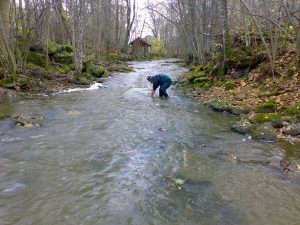In this post, Mirco Bundschuh highlights the results of his recent paper “Interactive effects of an insecticide and a fungicide on different organism groups and ecosystem functioning in a stream detrital food web”.
Chemical stressors can – driven by their toxic mode of action – act on different trophic levels within food webs and thus potentially cause unpredictable effects in situations of joint exposure scenarios.
In our study, we tested the impact of a model fungicide and a model insecticide on a stream detrital food web consisting of detritivores (Isopoda: Asellus aquaticus) and microbes (an assemblage of fungal hyphomycetes), both consuming leaf litter. We found that leaf decomposition rates were more strongly impacted by the fungicide than the insecticide. This can be explained by negative effects on leaf processing by detritivores due to a knock-on consequence of reduced fungal biomass and increased detritivore mortality. Moreover, fungal sporulation was elevated by the individual exposure to both the insecticide and fungicide, which may indicate a stress-induced increase in investment in dispersal. The combined action of both pesticides reduced fungal sporulation but increased detritivore mortality relative to the individual stressor treatments.
Our data demonstrates the potential of chemical stressors to interact at multiple trophic levels ultimately modulating ecosystem-level impacts. However, it is challenging to predict those impacts, since effect assessments are usually based on individual chemical stressors.
The paper was co-authored by Mirco Bundschuh in collaboration with colleagues from the Swedish University of Agricultural Sciences and is published in Aquatic Toxicology.
You may also be interested in:
Fungicides: do environmentally relevant concentrations affect reproduction in leaf-shredders?
Does the exposure pathway influence fungicides’ toxicity?
What are you working on? Part I: Team “Functional Aquatic Ecotoxicology”

